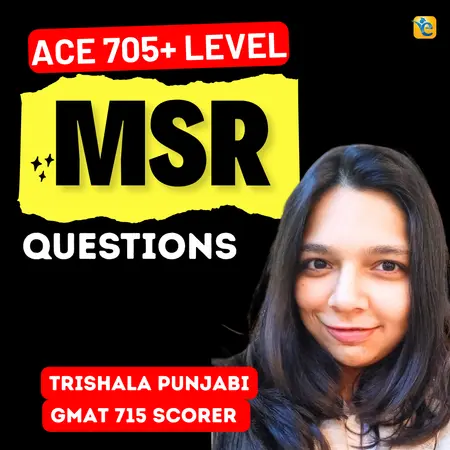Events & Promotions
|
|

GMAT Club Daily Prep
Thank you for using the timer - this advanced tool can estimate your performance and suggest more practice questions. We have subscribed you to Daily Prep Questions via email.
Customized
for You
Track
Your Progress
Practice
Pays
Not interested in getting valuable practice questions and articles delivered to your email? No problem, unsubscribe here.
- Nov 18
11:00 AM PST
-12:00 PM PST
Join us in a live GMAT practice session and solve 30 challenging GMAT questions with other test takers in timed conditions, covering GMAT Quant, Data Sufficiency, Data Insights, Reading Comprehension, and Critical Reasoning questions. - Nov 22
11:00 AM IST
-01:00 PM IST
Do RC/MSR passages scare you? e-GMAT is conducting a masterclass to help you learn – Learn effective reading strategies Tackle difficult RC & MSR with confidence Excel in timed test environment - Nov 23
11:00 AM IST
-01:00 PM IST
Attend this free GMAT Algebra Webinar and learn how to master the most challenging Inequalities and Absolute Value problems with ease. - Nov 25
10:00 AM EST
-11:00 AM EST
Prefer video-based learning? The Target Test Prep OnDemand course is a one-of-a-kind video masterclass featuring 400 hours of lecture-style teaching by Scott Woodbury-Stewart, founder of Target Test Prep and one of the most accomplished GMAT instructors.
B
Be sure to select an answer first to save it in the Error Log before revealing the correct answer (OA)!
Difficulty:
 95%
(hard)
95%
(hard)
Question Stats:
42% (02:17) correct 58%
(02:19)
wrong
58%
(02:19)
wrong  based on 3038
sessions
based on 3038
sessions
History
Date
Time
Result
Not Attempted Yet
Shy adolescents often devote themselves totally to a hobby to help distract them from the loneliness brought on by their shyness. Sometimes they are able to become friends with others who share their hobby. But if they lose interest in that hobby, their loneliness may be exacerbated. So developing an all-consuming hobby is not a successful strategy for overcoming adolescent loneliness.
Which one of the following assumptions does the argument depend on?
(A) Eventually, shy adolescents are going to want a wider circle of friends than is provided by their hobby.
(B) No successful strategy for overcoming adolescent loneliness ever intensifies that loneliness.
(C) Shy adolescents will lose interest in their hobbies if they do not make friends through their engagement in those hobbies.
(D) Some other strategy for overcoming adolescent loneliness is generally more successful than is developing an all-consuming hobby.
(E) Shy adolescents devote themselves to hobbies mainly because they want to make friends.
Which one of the following assumptions does the argument depend on?
(A) Eventually, shy adolescents are going to want a wider circle of friends than is provided by their hobby.
(B) No successful strategy for overcoming adolescent loneliness ever intensifies that loneliness.
(C) Shy adolescents will lose interest in their hobbies if they do not make friends through their engagement in those hobbies.
(D) Some other strategy for overcoming adolescent loneliness is generally more successful than is developing an all-consuming hobby.
(E) Shy adolescents devote themselves to hobbies mainly because they want to make friends.
Kudos
Bookmarks
Hey All,
You got to the right answer, for the right reason, already, so I only have one thing to add. The way to improve generally at CR is to start to recognize patterns in both the passage structures and the answer choices. For what it's worth, this question falls into one of the 4 categories we separate out within the greater category of "assumption" questions.
The first category (represented in this question) is "logic gap". Just as honeyrai so efficiently explained, there is a syllogism here with a missing piece. In case you've forgotten, a syllogism is a logical argument that works in this way: If a = b and b = c, then a = c. Logic gap questions tend to say a = b, so a = c, and we lose out on that important b = c part. If you start to recognize this as a pattern that comes back again and again, you're more likely not to fall for a trick or trap.
Word up.
Hope that helps!
You got to the right answer, for the right reason, already, so I only have one thing to add. The way to improve generally at CR is to start to recognize patterns in both the passage structures and the answer choices. For what it's worth, this question falls into one of the 4 categories we separate out within the greater category of "assumption" questions.
The first category (represented in this question) is "logic gap". Just as honeyrai so efficiently explained, there is a syllogism here with a missing piece. In case you've forgotten, a syllogism is a logical argument that works in this way: If a = b and b = c, then a = c. Logic gap questions tend to say a = b, so a = c, and we lose out on that important b = c part. If you start to recognize this as a pattern that comes back again and again, you're more likely not to fall for a trick or trap.
Word up.
Hope that helps!
Kudos
Bookmarks
SudiptoGmat
IMO B.
Assumptions are unsaid premises. They are those missing links that would complete the story. Everything moves fine till we encounter lasts sentence. That seems a bit out of place. Stem says that shy kids develop hobbies---> hobbies help them find friends ---> is they loose hobby then loneliness increases (fine) ---> Therefore, hobby is not a good idea?? Well there is a missing link between the last two lines.
And see that B is the only option that fits there. Hobby decreases loneliness---> loss of hobbies decrease loneliness---> any strategy that has a risk of intensifying loneliness isn't a good strategy---> Therefore, hobby isn't a good strategy.
Makes sense, doesn't it!














